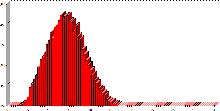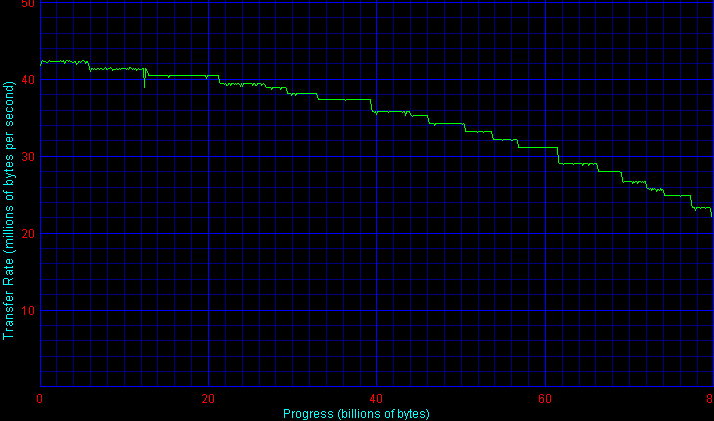|

The 5400 RPM WD800AB incorporates two 40-gig platters to yield its capacity of 80 GB. This is interestingly a platter less than the manufacturer’s premiere 7200 RPM drives. This tactic is somewhat opposite of rival Maxtor who incorporates just two platters into its performance series drive while maintaining four disks in its 5400 RPM line. WD specs the drive’s access time at a rather sedate 9.5 milliseconds. A standard 2-megabyte buffer completes the offering.

Let’s see how the WD800AB stacks up to the competition.
Low-Level ResultsFor diagnostic purposes only, StorageReview measures the following low-level parameters: Average Read Access Time– An average of 25,000 random accesses of a single sector each conducted through IPEAK SPT’s AnalyzeDisk suite. The high sample size permits a much more accurate reading than most typical benchmarks deliver and provides an excellent figure with which one may contrast the claimed access time (claimed seek time + the drive spindle speed’s average rotational latency) provided by manufacturers. WB99 Disk/Read Transfer Rate – Begin– The sequential transfer rate attained by the outermost zones in the hard disk. The figure typically represents the highest sustained transfer rate a drive delivers. WB99 Disk/Read Transfer Rate – End– The sequential transfer rate attained by the innermost zones in the hard disk. The figure typically represents the lowest sustained transfer rate a drive delivers. |
For more information, please click here.
|
Note: Scores on top are better. |
|
|||||||||||||||||||||||||||||||||
|
|
||||||||||||||||||||||||||||||||
WD800AB Average Read Service Time |
WD800AB Average Write Service Time |
||||||||||||||||||||||||||||||||
AnalyzeDisk pegs the WD800AB’s access time at 14.1 milliseconds, a score quite good for a 5400 RPM drive. Subtracting 5.6 milliseconds to account for the average rotational latency of a 5400 RPM spindle speed yields a measured seek time of just 8.5 milliseconds, a figure that handily beats WD’s 9.5 ms claim. At 14.9 milliseconds, average write access time is equally impressive.
This brings up an interesting angle on Western Digital’s recent “5400 RPM” drives. A while back in a discussion thread that has unfortunately been lost, several readers pointed out that the 60-gig WD600AB featured a “nominal” spindle speed of 5400 RPM and rotation latency that was not 5.56 milliseconds as one would expect from such a drive but rather “nominally” 5.0 milliseconds, a figure that would represent a 6000 RPM unit. Assuming a rotational latency of 5.0 milliseconds yields a measured seek time of 9.1 ms, still well below the 9.5 ms claim. Any way you slice it, the drive over-performs in this particular test.
|
Note: Scores on top are better. |
|
|||||||||||||||||||||||||||||||||
|
|
||||||||||||||||||||||||||||||||
WD800AB Transfer Rate |
|||||||||||||||||||||||||||||||||
The WD800AB delivers an impressive 42.0 MB/sec transfer rate in its outer tracks, again an impressive feat for a 5400 RPM drive. This score combined with an inner-zone mark of 24.5 MB/sec places the drive well ahead of the competition.
Do these impressive low-level scores yield better application-level marks? Let’s move on.
Single-User PerformanceStorageReview uses the following tests to assess non-server use: StorageReview.com Office DriveMark 2002– A capture of 30 minutes of actual computer productivity use that exactingly recreates a typical office-style multitasking environment. The applications include: Outlook XP, Word XP, Excel XP, PowerPoint XP, Calypso (a freeware e-mail client), SecureCRT v3.3 (a telnet/SSH client), CuteFTP Pro v1.0 (an FTP/SSH client), ICQ 2000b), Palm Hotsync 4.0, Gravity 2.3 (a Usenet/newsgroups client), PaintShop Pro v7.0, Media Player v8 for the occasional MP3, and Internet Explorer 6.0. StorageReview.com High-End DriveMark 2002– A capture of VeriTest’s Content Creation Winstone 2001 suite. Applications include Adobe Photoshop v5.5, Adobe Premiere v5.1, Macromedia Director v8.0, Macromedia Dreamweaver v3.0, Netscape Navigator v4.73, and Sonic Foundry Sound Forge v4.5. Unlike typical productivity applications, high-end audio- and video- editing programs are run in a more serial and less multitasked manner. The High-End DriveMark includes significantly more sequential transfers and write (as opposed to read) operations. |
StorageReview.com Bootup DriveMark 2002– A capture of the rather unusual Windows XP bootup process. Windows XP’s boot procedure involves significantly different access patterns and queue depths than those found in other disk accesses. This test recreates Windows XP’s bootup from the initial bootstrap load all the way to initialization and loading of the following memory-resident utilities: Dimension4 (a time synchronizer), Norton Antivirus 2002 AutoProtect, Palm Hotsync v4.0, and ICQ 2000b.
StorageReview.com Gaming DriveMark 2002– A weighted average of the disk accesses featured in five popular PC games: Lionhead’s Black & White v1.1, Valve’s Half-Life: Counterstrike v1.3, Blizzard’s Diablo 2: Lord of Destruction v1.09b, Maxis’s The Sims: House Party v1.0, and Epic’s Unreal Tournament v4.36. Games, of course, are not multitasked- all five titles were run in a serial fashion featuring approximately half an hour of play time per game.
For more information, please click here.
|
Note: Scores on top are better. |
The WD800AB’s StorageReview.com Office DriveMark 2002 of 286 I/Os per second easily bests the competition and rivals the score of many 7200 RPM units. As a high-level test, the Office DriveMark is capacity dependent and makes the Caviar’s 6% advantages over the twice-as-large Maxtor DiamondMax D540X impressive indeed.
In the High-End DriveMark 2002, the Caviar’s relative score is even better. At 275 I/Os per second the WD800AB manages to slip by even 7200 RPM offerings from Seagate and Maxtor (not shown above; check out SR’s Drive Performance Database for 7200 RPM scores)! The Bootup DriveMark continues the trend, placing the WD800AB not only beyond the reach of Seagate and Maxtor’s high-end units but also IBM’s Deskstar 120GXP.
And while the Caviar slips somewhat behind the competition’s 7200 RPM drives in the Gaming DriveMark, it nonetheless maintains impressive margins in leading the 5400 RPM pack.
Multi-User PerformanceStorageReview uses the following tests to assess server performance: StorageReview.com File Server DriveMark 2002– A mix of synthetically-created reads and writes through IOMeter that attempts to model the heavily random access that a dedicated file server experiences. Individual tests are run under loads with 1 I/O, 4 I/Os, 16 I/Os, and 64 I/Os outstanding. The Server DriveMark is a convenient at-a-glance figure derived from the weighted average of results obtained from the four different loads. StorageReview.com Web Server DriveMark 2002– A mix of synthetically-created reads through IOMeter that attempts to model the heavily random access that a dedicated web server experiences. Individual tests are run under loads with 1 I/O, 4 I/Os, 16 I/Os, and 64 I/Os outstanding. The Server DriveMark is a convenient at-a-glance figure derived from the weighted average of results obtained from the four different loads. For more information click here. |
|
Note: Scores on top are better. |
|
|||||||||||||||||||||||||||||||||
|
|
||||||||||||||||||||||||||||||||
5400 RPM drives simply aren’t meant to make their way into the highly random environment of servers. As impressive as it has been so far, the WD800AB is no exception. The Caviar’s score of 118 and 119 I/Os per second respective in the SR File Server DriveMark and Web Server DriveMark, while the best of 5400 RPM drives, nonetheless lags behind that of 7200 RPM ATA units and especially that of just about all SCSI drives.
Legacy PerformanceeTesting Lab’s WinBench 99 Disk WinMark tests are benchmarks that attempt to measure desktop performance through a rather dated recording of high-level applications. Despite their age, the Disk WinMarks are somewhat of an industry standard. The following results serve only as a reference; SR does not factor them into final judgments and recommends that readers do the same. |
|
Note: Scores on top are better. |
|
|||||||||||||||||||||||||||||||||
|
|
||||||||||||||||||||||||||||||||
Heat and NoiseIdle Noise– The sound pressure emitted from a drive measured at a distance of 18 millimeters. The close-field measurement allows for increased resolution between drive sound pressures and eliminates interactions from outside environmental noise. Note that while the measurement is an A-weighted decibel score that weighs frequencies in proportion to human ear sensitivity, a low score does not necessarily predict whether or not a drive will exhibit a high-pitch whine that some may find intrusive. Conversely, a high score does not necessarily indicate that the drive exhibits an intrusive noise envelope. Net Drive Temperature– The highest temperature recorded from a 16-point sample of a drive’s top plate after it has been under heavy load for 80 minutes. The figures provided are net temperatures representing the difference between the measured drive temperature and ambient temperature. For more information, please click here. |
|
Note: Scores on top are better. |
|
|||||||||||||||||||||||||||||||||
|
|
||||||||||||||||||||||||||||||||
As discussed earlier, the WD800AB may feature a spindle speed slightly higher than the 5400 RPM that WD claims. While it may yield some slight performance increases, what costs does this approach exact when it comes to noise and heat?
With an objectively-measured idle noise of 43.7 db/A at 18 millimeters, the Caviar’s noise floor is in line with the competition. Subjectively speaking, idle noise is inaudible while seeks may be barely discerned above the fans of our testbed’s CPU and power supply.
The WD800AB’s net drive temperature weighs in at 17.6 degrees celsius, on the high-end for value-class units. It’s still cooler than most 7200 RPM drives, however, and can be integrated into most systems with ease.
ConclusionWestern Digital’s Caviar WD800AB delivers mighty impressive performance for a value-class drive. While the drive’s low-level and application-level measurements hint that it may in fact feature a spindle speed greater than 5400 RPM, heat, noise, and cost levels remain in line with the competition. The only drawback is the drive’s 80 GB capacity. This may not only be too little for those to whom the DiamondMax D540X’s 120 to 160 GB sizes appeal but also too much for those seeking smaller capacity points. Though smaller versions of the WD800AB may exist, WD’s rather unfriendly naming scheme unfortunately makes it difficult to tell to which family a given drive belongs. |
That said, if you’re seeking a drive around 80 GB in capacity that’s fast, cool, quiet, and inexpensive, the WD800AB should be the drive you buy.




 Amazon
Amazon